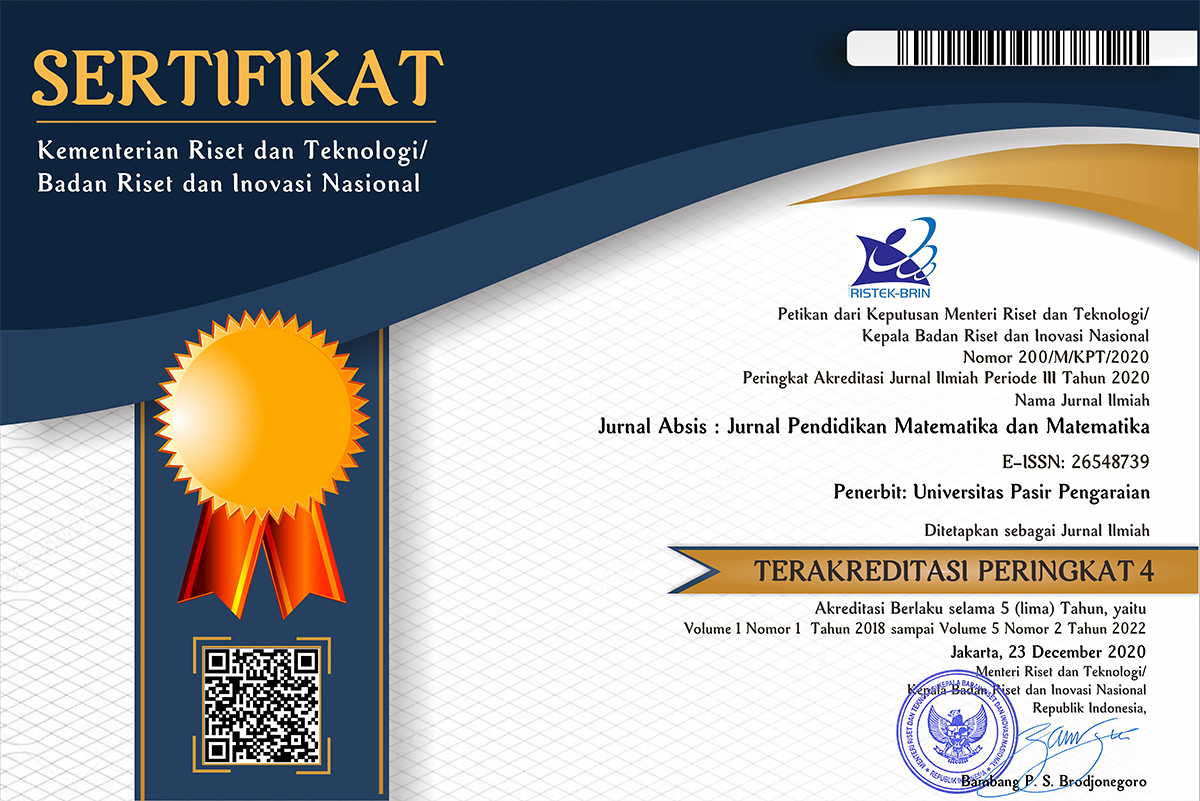Deskripsi Kemampuan Berpikir Kreatif Matematis Mahasiswa Ditinjau dari Kemampuan Awal Matematika
DOI:
https://doi.org/10.30606/absis.v4i1.843Keywords:
Berpikir Kreatif Matematis, kemampuan awal matematika, mathematical creative thinking, early mathematical skills, introduction to basic mathematicsAbstract
This research aims to describe students' ability in mathematical creative thinking in terms of the initial ability of mathematics, in the set material, relationship of functions, and mathematical logic, in the course Introduction to Basic Mathematics (PDM). Qualitative descriptive is used as a research method and is carried out at Indraprasta University PGRI Jakarta. Three students who took the Introductory Basic Mathematics course in the odd semester of the academic year 2020/2021, were selected as research subjects. The taking of the subject is done using purposive sampling. The instruments used are tests of mathematical creative thinking skills and early mathematical abilities, interview guidelines, and researchers as key instruments. Activities in this data analysis include data reduction, data display, and verification. The validity test of this research uses triangulation. This study shows that students' mathematical creative thinking skills are still lacking in indicators of flexibility, smoothness, and originality, especially in students with low initial ability.
Downloads
References
Aqda, M. F., Hamidi, F., & Ghorbandordinejad, F. (2011). The impact of constructivist and cognitive distance instructional design on the learner’s creativity. Procedia Computer Science, 3(March 2014), 260–265. https://doi.org/10.1016/j.procs.2010. 12.044.
Ario, M. (2019). Profil Kemampuan Awal Matematis Mahasiswa Pendidikan Matematika. Jurnal Absis : Jurnal Pendidikan Matematika Dan Matematika, 1(2), 72–77. https://doi.org/10.30606/absis.v1i2.90
Hidayat, D., Nurlaelah, E., & Dahlan, J. A. (2017). Rigorous Mathematical Thinking Approach to Enhance Students’ Mathematical Creative and Critical Thinking Abilities. Journal of Physics: Conference Series, 895(1). https://doi.org/ 10.1088/1742-6596/895/ 1/012087.
Jamaan, E. Z., Musnir, D. N., & Syahrial, Z. (2020). The effect of problem-based learning model on students’ geometry achievement by controlling mathematics initial ability. Journal of Physics: Conference Series, 1554(1). https://doi.org/10.1088/ 1742-6596/1554/1/012034
Kadir & La Masi. (2014). Mathematical Creative Thinking Skills Of Students Junior High School In Kendari City. International Seminar on Innovation in Mathematics and Mathematics Education, 295–306.
Lin, C.-Y. (2017). Threshold Effects of Creative Problem-Solving Attributes on Creativity in the Math Abilities of Taiwanese Upper Elementary Students. Education Research International, 2017, 1–9. https://doi.org/10.1155/2017/4571383.
Lince, R. (2016). Creative Thinking Ability to Increase Student Mathematical of Junior High School by Applying Models Numbered Heads Together. Journal of Education and Practice, 7(6), 206–212.
Novita, R., & Putra, M. (2016). Using Task Like Pisa’s Problem to Support Student’s. Journal on Mathematics Education, 7(1), 31–42. http://doi.org/10.22342/jme.7. 1.2815.31-42.
Nurrahmah, A., & Karim, A. (2018). Analisis Kemampuan Pembuktian Matematis Pada Matakuliah Teori Bilangan. JURNAL E-DuMath, 4(2), 21. https://doi.org/10.26638/ je. 753.2064
Qadri, L., Ikhsan, M., & Yusrizal, Y. (2019). Mathematical Creative Thinking Ability for Students Through REACT Strategies. International Journal for Educational and Vocational Studies, 1(1), 58. https://doi.org/10.29103/ijevs.v1i1.1483.
Siswono, T. Y. E. (2010). Leveling Student’s Creativity in Solving and Posing Matehematical Problem. IndoMS. J.M.E, 1(1), 17–40.
Sriraman, B., Haavold, P., & Lee, K. (2013). Mathematical creativity and giftedness: A commentary on and review of theory, new operational views, and ways forward. ZDM - International Journal on Mathematics Education, 45(2), 215–225. https://doi.org/10.1007/s11858-013-0494-6.
Sugiyono. (2011). Metode penelitian kombinasi (mixed methods). Bandung: Alfabeta.
Suryana, A., & Ningsih, R. (2018). Analysis of Engineering Students ’ Difficulty in Solving the Problem of Mathematical Understanding on Calculus Course. Prosiding Diskusi Panel Nasional Pendidikan Matematika 2018, 2(1).
Thuneberg, H. M., Salmi, H. S., & Bogner, F. X. (2018). How creativity, autonomy and visual reasoning contribute to cognitive learning in a STEAM hands-on inquiry-based math module. Thinking Skills and Creativity, 29(April), 153–160. https://doi.org/10.1016/j.tsc.2018.07.003.
Tri, P. S., & Munandar, D. R. (2021). Analisis Kendala Pembelajaran Matematika Berbasis Online (E-Learning) Pada Masa Pandemi COVID-19. Jurnal Absis : Jurnal Pendidikan Matematika Dan Matematika, 3(2), 320–327. https://doi.org/ 10.30606/ absis.v3i2.811
Yazar Soyadı, B. B. (2015). Creative and Critical Thinking Skills in Problem-based Learning Environments. Journal of Gifted Education and Creativity, 2(2), 71–71. https://doi.org/10.18200/jgedc.2015214253.








